Many people have asked me how we got our kids to love snowshoeing at such an early age. We rarely snowshoe without all three of them in tow. People find it hard to believe our 10-year-old still likes to go after all these years, our 3-year-old will go all day, or that our 20-month-old is already snowshoeing. I have even had questions regarding how to find snowshoes for toddlers and kids. Thus, here are my reasons for why you should go, how to choose a snowshoe, and tips for a successful first snowshoeing outing with your toddlers and kids.
Why you should go snowshoeing with kids and toddlers
For me, snowshoeing with my kids is a chance to spend time with them outside of the distractions of everyday life. No video games, phones, or computers. None of the day-to-day worries that take up so much of our time.
Snowshoeing with my kids and toddlers is also a time for me to instill a foundation for being physically active. Our children never get tired of trying to hide behind trees and scare us or making trails in different directions, trying to confuse us about where they went.
Snowshoeing has quickly become an activity that we love to do together as a family. For me, that is priceless. We go all day and never hear any complaints. But, they know that if they need to stop, we will and that our number one rule while snowshoeing is to have fun. So, here I am handing out advice. I hope it leads you and your family to a lifelong love of snowshoeing.
Read More: Trekkin’ with Toddlers: Passing on the Snowshoeing Tradition
Tips for choosing the right snowshoe
I am by no means a professional. Furthermore, I am almost certain you could ask a dozen snowshoeing parents these questions only to receive a dozen different answers. My tips and advice merely come from years of trial and error. In fact, our oldest son has had to endure all of the mistakes we made over the years. You could say he was our little snowshoe guinea pig.
The first and most difficult decision you will have to make is choosing the right snowshoe for your child. There are a lot of good brands out there, and most offer a wide range of ‘shoes covering all skill levels and ages. It can be a bit overwhelming when you first start looking for a snowshoe for your child or toddler. Luckily this doesn’t have to be as hard as it may seem.
1. Highest price isn’t always the best
If you remember only one thing from this article, let it be this: Avoid the idea that the highest-priced product means it is always the best quality or the most comfortable. There are many superior-quality snowshoes out there that come with a surprisingly low price tag. In addition, many of these lower-priced shoes come with lifetime warranties, which is always good when you have one or multiple children.
2. Keep the snowshoe simple
Try to keep the snowshoe simple without any fancy features that provide little to no function for a child. Let’s face it. You’re probably not going to be crossing any steep, dangerous, or ice-covered mountains with your child. Therefore, they don’t have to have a $200 pair of snowshoes with special ice cleats or traction features.
3. Avoid using poles with toddlers when snowshoeing
It is also wise to avoid poles while your child is learning to snowshoe. The use of poles can lead to tripping and serve as a distraction. They can be a great piece of equipment for adults and older youth. However, poles are, in my opinion, too much for a toddler to have to think about on the outing.
4. Don’t buy too big of a snowshoe
Don’t shop with the mindset that you should buy a big snowshoe so they can grow into them. Snowshoes that are too big are extremely difficult to maneuver and can be painful to wear.
Most companies list a weight range, and I recommend that you choose a pair that puts your child in the middle of that range. For example, if your child weighs 40 lbs (18 kg), look for a snowshoe made for 30-50 pounds (14-23 kg) or even a 0-50 lb (0-23 kg) limit.
If you go with a shoe that puts your child at the top of the weight limit, you risk them not fitting more than a few weeks. We all know how quickly children grow. Similarly, never go with a snowshoe that has a lower limit than your child weighs. A lower limit makes it very difficult for the snowshoe to distribute the child’s weight evenly on the snow, which leaves them sinking.
5. Look for similar snowshoes in various sizes
Look for a brand that offers similar snowshoes in various sizes. Learning to work new bindings can be difficult for a young child. Once you find snowshoes that fit and your child learns to operate them, it is helpful to be able to purchase the next size up without a whole new system to learn.
Read More: Start’ Em, Young! Snowshoe Brands For Kids Two-To Teens
6. Call the company for more info
One of the most helpful steps to picking a great snowshoe is to call the company before you make the purchase. Even if you find a pair at a local sporting goods store, I suggest you call the manufacturer directly and speak with customer service.
Remember to ask questions
Ask questions about their warranty policy and any others that may affect your child individually. It is true you can get most, if not all, your questions answered at the location you purchase from or off the internet. However, the call to the manufacturer should be less about the information you get and more about the quality of customer service. I have called a company twice before to confirm the poor customer service I received from the first call was not just due to that specific representative having a bad day.
If the company isn’t willing to answer your simple questions or they are unfriendly before you buy, you can safely assume that the service will remain poor after you purchase the product. It is likely that if poor customer service exists and a problem occurs with the snowshoes, it will be challenging to get it resolved.
Call more than once
I also encourage you to call more than once, as I did, to ensure you are receiving the same information. Unfortunately, there have been times I have called and been told one thing. Then I found out later a different representative had different information. So call as many times as it takes to make you feel comfortable. Whatever company you choose to purchase from, you should be completely satisfied with them in ALL areas of the purchase.
7. Let your child help choose their snowshoe
Another tip for choosing the right snowshoe is to let your child help make the decision. You can either take them with you to the store or allow them to shop online with you. However, either way, they must play an active role in the purchase.
Even at a very young age, they can point to them, try them on and look at pictures of them. If they are old enough to pick a color, go ahead and let them choose (even if you don’t like their color selection). Show them the brand or brands that you have researched, then let them choose from that selection. They are more likely to want to wear them if they get to be a part of the purchase.
8. Be timely with your purchase
Once you have decided on a brand of snowshoes, determined your child’s size range, and picked your color, it is time to make the purchase. Buy your snowshoes before the snow season starts. Depending on where you live, this may require you to order online but, the money you save on the off-season purchase will more than cover the cost of any shipping you have to pay.
Also, keep in mind, learning to snowshoe will inevitably cause scratches on their snowshoe no matter what age your child is at the moment. It will mean they drag them everywhere when not strapped on their feet, and at some point, they will throw them in the car with no regard for the position of the crampons. All of this can wreak havoc on a pair of snowshoes and your nerves. However, knowing you got a great deal on a quality pair of snowshoes can help you to relax and let your child learn.
Read More: Start’ Em, Young! Snowshoe Brands For Kids Two-To Teens
9. Try the snowshoes on early
Once your new snowshoes arrive, strap them on. Pull out the snow boots in the middle of summer. We have found our kids are most excited about their new snowshoes when they first open them, so take advantage of the new toy excitement. No one likes to get a gift in August and have to look at it until December without getting to play with it.
On a side note, do use caution. The crampons can be sharp and may cause problems, primarily if used to smash the hand of a sibling (trust me). Let your child wear their new snowshoes around the house. It is unlikely that a quality crampon will be damaged by a child trekking around on the carpet.
By trying the snowshoes on early, it is your chance to put them on your toddler or child and watch for any signs of discomfort. Most stores will accept the snowshoes as a return if not worn outside. You know your child better than anyone else, so use that parental instinct to identify if your purchase is right for your child.
10. Tackle problems early
If there is a problem while trying on your snowshoe, take notice of it right away. If you purchase in person, do not let a sales representative make you feel pressured into another brand you have not researched. Do not let them tell you your child will get used to the discomfort.
A few visible signs of discomfort may include:
- Pulling at one shoe more than the other
- Shaking their legs
- Trying to take them off while whining or crying.
Although wearing snowshoes for the first time may be awkward for a toddler, they should not hurt. If the problem persists, physically examine the snowshoe. Take a look at the bindings. If they are too tight or too loose, it can be a problem. Your child’s snow boots may also cause discomfort.
11. Boots are just as important as snowshoes
It is best to have a boot that laces up and can be secured firmly to the foot. Slip-on style boots can leave room for shifting or even slipping off with the weight of the snowshoe. Shifting or slipping can create pain, discomfort, or also cause the child to fall.
If inspecting the boot does not resolve the discomfort, it is my opinion you should return to your search. If you purchased online, take the necessary steps to return the snowshoes to the retailer. Or, if you are in the store, do take the time to try on the other brands. However, as I stated earlier, I highly recommend going home to research thoroughly any new brands you consider, without any pressure.
Read More: Snowshoeing Footwear: Tips for Choosing Your Boot
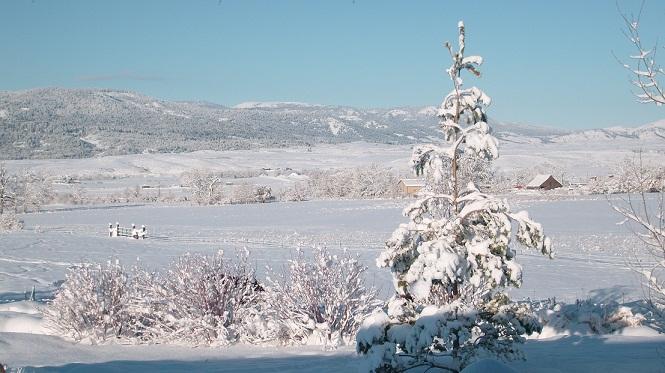
Choosing the right snowshoe can lead to a fun and successful outing with toddlers and kids. Photo: Ryan Alford
Tips for your first snowshoe outing
When the first snow starts to fall, you should have a quality pair of snowshoes for a reasonable price. Plus, you’ll have a child who is comfortable in them after wearing them around the house for the last few months. So, it is now time to hit the trail and go snowshoeing with your toddlers!
Our kids loved learning in the fresh powder. Although the powder is not always the easiest to trek on, it is by far the softest to fall in. No matter how good your toddler or child has done around the house, be prepared for challenges outside. It is incredible to watch a child learn a new skill, so plan your first few trips around them.
Read More: 10 Tips For Making Snowshoeing Fun With Kids
1. Start small
For your first trip, don’t expect to go any measurable distance. Our daughter’s first trip was about an hour. We made it all of 200 yards. She spent the majority of the time stopping to point at her snowshoes, saying, “see cute.” It was imperative to her that we all saw every flake of snow that touched her new purple shoes. Although mastering the technique may not be a challenge for your child, overcoming the excitement of walking on snow may slow down your trip.
It’s also important to start small because pushing your little learner too hard will only cause a loss of interest in the activity. Although you have to use your judgment, we usually try to shoot for a first snowshoeing destination of no more than 0.5 miles (0.8 km) in each direction. Then, stop halfway up and build a snowman to knock it down on the way back.
Stopping halfway breaks up the trip into little distances and gives the child something to look forward to in both directions. Then, on the way back, when our kids see the little snowman in the distance, it usually gives them a second wind and inspires an impromptu race to the goal.
2. Set a goal for your destination
After you have provided adequate time for your child to get acquainted with snowshoeing, it is time to set a goal destination. Every child is different, and the time it takes them to reach this goal will vary. Our kids were ready for this step after about three small outings.
Choose a destination that has something appealing to a child. For example, a trail with a bridge is always an appealing destination since most kids enjoy throwing rocks or snowballs into the water or at the ice if it is frozen. However, please do not overdo it. If your child tires before you reach the destination, make sure to stop, even if it is just for a break, a snack, or lunch.
3. Take a snowshoeing trip to explore
Once you have mastered a couple of destination trips, take a trip or two to nowhere. Since snowshoes leave distinct tracks wherever kids go, losing them is near impossible. Plus, being able to explore only helps to build their abilities. Our children love just trekking. We look for all kinds of treasures and animal tracks.
However, be careful with distance on exploration trips. It always seems easy to walk away, but it doesn’t take long to travel farther than you should have gone. If you go too far, having to go back for a long distance can be a real challenge for kids.
4. Watch for signs of tiring
When you’re out snowshoeing with your toddlers or kids, it’s essential to watch for signs that your child is tiring. I always look for signs. For example, I watch to see if they stop running from place to place or if they begin to walk in a straight line instead of swerving in a curvy playful way. My middle son always started out wanting to be the leader, and inevitably as he became tired, he moved behind me. This behavior was always a red flag that it was time to break and turn around. Of course, you can always head in another direction if you get back to your starting point and the kids still have energy.
Read More: How To Plan a Snowshoe or Hiking Outing With Kids
Go out and enjoy snowshoeing with toddlers and kids
Once you have purchased quality snowshoes, played in them around the house, and ventured out to play in fresh powder, your child will be hooked for a lifetime. The opportunity to play, relax, and be physically active will be something the whole family can look forward to regularly. If you choose to introduce your child to snowshoeing, you give them a chance to create a lifelong love of the outdoors.
For more ideas for planning a family snow trip, visit The Family Travel Files.
Have you been snowshoeing with toddlers or kids? What tips or recommendations have helped you in the process?
This article was first published on January 15, 2012. It was most recently updated on November 30, 2021.
Read Next: The Myth That Snowshoeing is Boring (and How to Avoid It)


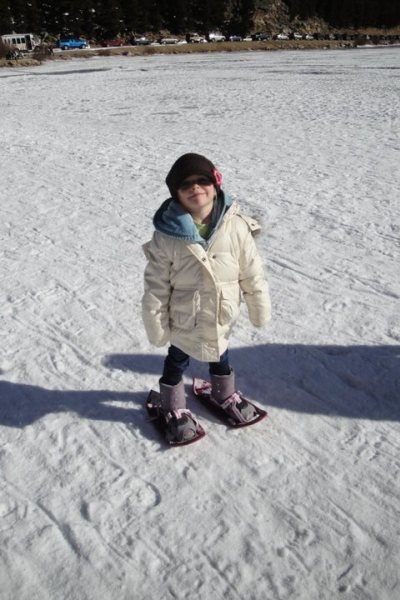
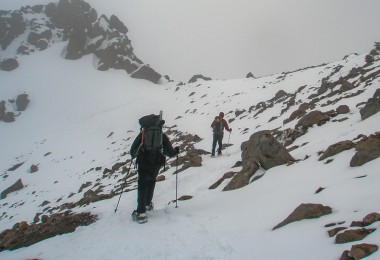
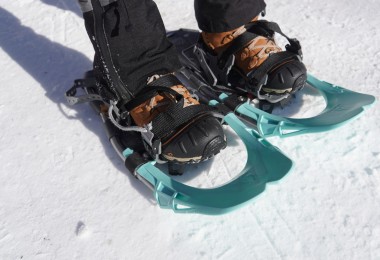
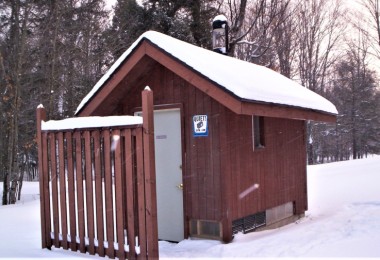
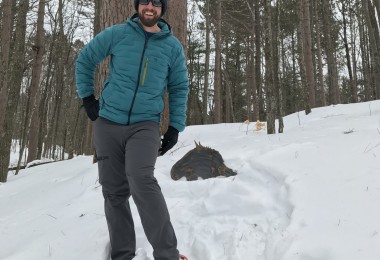

I have a 2.5 year old who weighs 22 lbs. Any suggestions on finding ones that will fit? Last winter we used the back pack carrier or sleigh would love to get him trekking.
Hi Camille,
That’s a great question! There are a few different brands I would recommend checking out. The Tubbs Snowflake Snowshoe for 2.5-4 year olds could be a great option.
Redfeather Snowshoes also offer their Snowpaw Snowshoe
These are recommended for ages 3-7, but I would suggest calling them directly regarding the weight recommendations to see if they would be a good match.
We also have some other snowshoe options for toddlers and children in our article Start ’em Young! Snowshoes for Kids Two to Teens”
I hope that can provide a starting point and we’d be happy to answer any other questions!
I enjoyed reading your article, thank you for sharing this! I am presently looking to get my daughter started with snowshoeing and fostering her love of being outdoors in the snow. She is 21 months old, just under 3ft tall and weighs 29 lbs. I am having difficulty finding the correct size snowshoes for her. Do you have any specific recommendations? Yukon Charlies snowshoes seem geared towards older children.
Thank you!
– Erin
You said your baby was 20 months when learning, but the Yukon Charlie’s say that Size 11 is an ideal fit. Did his/her little Size 6/7 boots work okay?
I’m wondering the same? Wanted to get a pair for my son but he’s 18m wearing Toddler 6/7